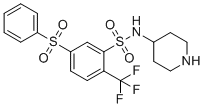According to study leader Nathan Hawkshaw, of the University of Manchester in England, this new drug has never been considered in the treatment of baldness. It has been seen that the this could promote human hair growth. He said this could make a difference to people suffering from hair loss one day. To become a reality however, the drug would need to pass through clinical trials that would show it is effective in re-growing hair and also safe for use.
The researchers explain that at present there are only two drugs – Minoxidil and Finasterite that can help temporarily and relatively unsuccessfully in male pattern of baldness. These drugs are however fraught with side effects and are not always successful. While minoxidil can be used for both men and women, finasteride is useful only in men.
Minoxidil  Finasterite
Finasterite 
 Finasterite
Finasterite 
Hawkshaw and his colleagues thus went ahead to explore the drug WAY-316606 that was originally developed to stop bone loss seen in osteoporosis. The drug is shown to inhibit the production of a protein called SFRP1. This protein is responsible for hair loss and inhibits growths of several other tissues by blocking a WNT molecular pathway. When used on hair follicles thus, WAY-316606 showed benefits and hair regrowth.
 WAY-316606
WAY-316606
The researchers used samples from the lab containing scalp hair follicles from over 40 male hair-transplant patients and were pleased to report encouraging results with the test drug.
Baldness or pathological hair loss
One of the most common forms of hair loss is male pattern baldness. It affects around 50% of men by time they reach the age of 50. It is usually hereditary and thought to be associated with having an excess of a certain hormones, which has an effect on hair follicles. The hair loss usually begins while a man is in his late 20s or early 30s. Female pattern baldness most commonly affects post-menopausal women, possibly as a result of hormonal changes. Alopecia areata commonly manifests as patchy baldness that may resolve and then recur. It can affect both men and women at any age. It is caused by an immune system disorder and people with autoimmune conditions are more likely to be affected. In one fifth of cases, alopecia areata is hereditary. Alopecia or baldness can also be due to scars or cicatricial alopecia. The hair follicles are completely destroyed and hair does not grow again. The condition affects both males and females and is more common among adults than children.
Ref : http://journals.plos.org/plosbiology/article?id=10.1371/journal.pbio.2003705
